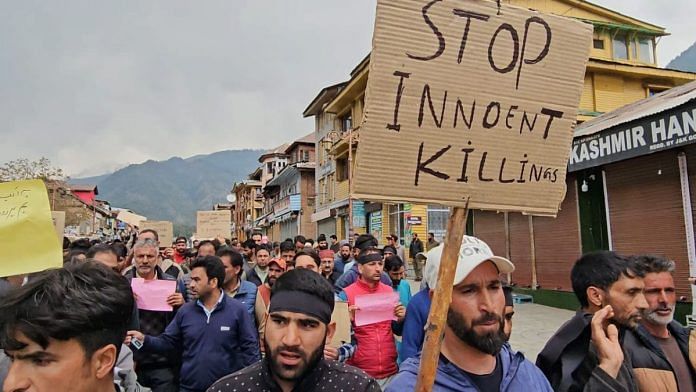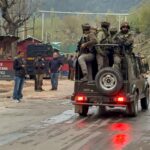Assistance did arrive, but it was too late. A PCR call was made at 2:45 pm, and by the time the forces reached the site—having trekked an unmotorable access road—the bloodshed was over, and the terrorists had escaped.
Twenty-five tourists and a local resident were killed, and several others injured in one of the deadliest attacks in the Kashmir Valley in recent years. This is why the Pahalgam terror attack is ThePrint’s Newsmaker of the Week.
As India listened to the heart-wrenching accounts of eyewitnesses—accounts that stirred anger, shock, and debate—one question haunted everyone: Why was there no security deployment in the area during peak tourist season? Could the attack have been prevented? Could the casualties have been fewer if help had arrived on time? Probably.
Sources in the security establishment admitted it was a lapse—though they refrained from using that term. The timing was particularly significant, as US Vice-President JD Vance was in India on a four-day visit, and yet no special deployment had been made.
After the Chittisinghpora massacre in March 2000—when 35 Sikh men were shot dead on the eve of then-US President Bill Clinton’s visit—clear Standard Operating Procedures (SOPs) were put in place for such occasions. During any VVIP visit, high alert is declared across the Valley. However, no such arrangement was made for Baisaran, despite it being thronged by over 1,000 tourists daily—a clear lapse.
The Narendra Modi government reportedly told opposition leaders at an all-party meeting on Thursday evening that local tour operators had opened the route to tourists “without informing the administration,” which is why no security personnel were deployed in the area.
This explanation is, to say the least, laughable. Arguably worse than admitting a security lapse, it suggests that the police were unaware that thousands of tourists were traveling up and down the Valley daily.
But why did this happen? It seems that in Kashmir, the security forces either internalised—or were made to believe in—a false sense of “normalcy,” a narrative pushed by the government, which ultimately extracted a heavy price.
The narrative did succeed in attracting a record 2.36 crore tourists in 2024, the highest ever. But it seems to have also led to complacency among the forces, in line with the government’s messaging that “all is well” and “nothing could go wrong”. And that is probably why they were caught off guard.
Security forces claim that after the abrogation of Article 370, the government became very “lenient” and opened up many “unguarded spots” that had previously been closed due to security concerns—allowing unrestricted access to tourists.
This, despite repeated suggestions that such measures could be risky, especially with over 120 active terrorists—mainly from Lashkar-e-Taiba—still operating in the Valley.
The government, they said, was “not keen” on restricting access to these areas, as it contradicted the narrative. Only after the Pahalgam attack has the to limit tourist movement to such spots.
“No one thought this would happen, since tourists hadn’t been attacked in the past. We acknowledge we couldn’t prevent it, but there are limitations to how much force can be deployed in areas like these,” said one source.
A second source added, “Over the past few years, the government has been extremely liberal, insisting that all spots should remain open to tourists, as cordoning off any location would send the wrong message. This included areas that lack the necessary security deployment for handling large numbers of tourists.
“These spots are typically secured on a seasonal basis. But after the recent attack, a decision has been made to restrict access to them. This action was necessary.”
Speaking to ThePrint, a third source in the security establishment said the absence of recent terror attacks should not be mistaken for genuine normalcy—especially in Jammu and Kashmir, where periods of peace are often disrupted by sudden violence.
After the abrogation of Article 370 in August 2019, the Modi government maintained control over the region by deploying large military contingents, enforcing strict curfews, arresting overground workers, and carrying out anti-terror operations.
These measures helped maintain a semblance of order. But in 2020-2021, a spate of civilian killings shook the valley, with 38 and 41 civilians killed in separate attacks. After that, terror activity largely shifted to Jammu, which reported a series of attacks last year.
With the Pahalgam attack, the security forces are back in action. It has served as a wake-up call, jolting them out of complacency. Combing operations are underway, and over 100 people have been rounded up for questioning. Three of the six suspected terrorists involved have been identified, and their sketches released based on eyewitness accounts.
The priority now is to establish accountability and capture—or eliminate—those responsible for the Pahalgam attack.
More importantly, this moment demands reflection and a lesson worth repeating: the absence of violence is not normalcy. Vigilance must be constant. The adversary is watching, waiting for a lapse. The moment the guard is lowered, they strike. That is the opportunity they must never be given.
(Edited by Prashant)








